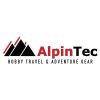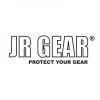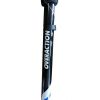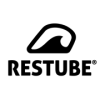ΙNFORMATION FOR CRAMPONS
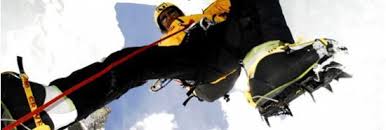
The mountaineering with snow without crampons is generally impossible. The crampons are metal frames with 10 vertical (downward) noses and usually two parallel forwardly. The crampons are adapted to the sole of the boot and serve to promote the hard snow or ice. The first authentic forged crampons were replaced by modern manufacturing equipment with emphasis on rigidity, reduced weight and maximum performance. The crampons marketed in three types:
1. Trekking Crampons
Classic hiking crampons are usually modular, with 2 or 3 joints. They are a light and a compromise solution that provides satisfactory performance in all types of low slope of snow. Simple hiking crampons need not have front noses. Made of special steel alloys and are medium strength. Due to low weight and many prefer to ski mountaineering. There crampons and aluminum only for special occasions.
2. Universal crampons
The Universal crampons for ice climbing, glacier crossing, rock climbing and ice climbing small size, designed for rigid or almost rigid boots, usually with horizontal front noses and are ideal for long difficult climbs in alpine ice and mountain hiking hard snow or frost. Made of special steel alloys.
3. Technical Crampons
This is especially crampons mainly for hard ice climbing and using a mixed field. Have jagged, vertical front noses, one or two points (mono point, multi point) and offer ease of setup nose and heel. They are made of special steel alloys, are heavier than those in general use, with great durability. In the technical crampons the front noses can be horizontal or vertical and slightly sloped or curved. The convex exploiting the curvilinear motion of the foot, achieve better penetration in ice. Often supported by two more on the front diagonal noses providing stability.
Fit to boot
The crampons must operate very well on the boot. A crampons are properly configured on the boot when they can stand without being tied straps.
The distance of the edge of the grate of the boots from the back of the heel must be not more than 5-10mm, when it is disposed. Unlike receptors crampons must not protrude forwardly. Therefore when purchasing crampons should be checked on the spot to adapt to boot. Depending on how the binding to the boot crampons are separated into:
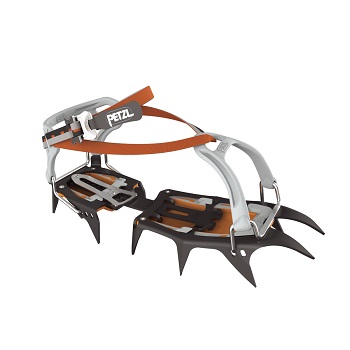
-
laces
The laces, are suitable for very flexible boots (low mountain) and swabs are not completely rigid or almost rigid softened. The disadvantage is that in mixed ice routes - the rock is consuming the necessary "pull out - put" but have the advantage of being adapted to all types of boots.
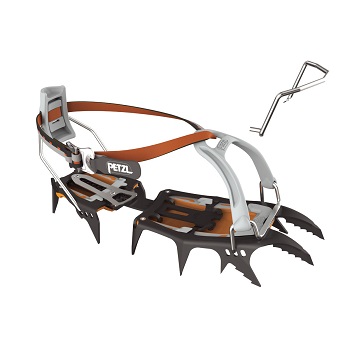
-
semi fast
The semi fast have the same fastening system at the rear of the boot to that of fast, but in front have an intelligent fastening system with plastic strains and webbing. So it can be used in a wider range of boots. The installation time of the boot is as fast with these fast crampons.
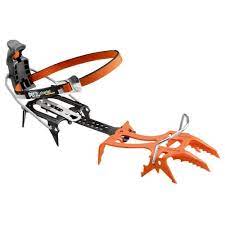
-
fast
The fast crampons as indicated by their name come and go quickly through the mechanism available and consists of a bar at the front which catches the special groove having for this reason boots and a clip, similar to having the ski bindings, which engages in another recess in the back of the boot. Απαιτείται ιδιαίτερη προσοχή και ρύθμιση ώστε τα κραμπόν να προσαρμόζουν άριστα πάνω στη μπότα, ιδίως όταν αυτή είναι παγωμένη. For best bonding, but also for any loss if the crampons unfastened, there is a belt clip that ties around the ankle. The fast crampons are only suitable for rigid high and ultrahigh Mountain boots.
Anti-snow
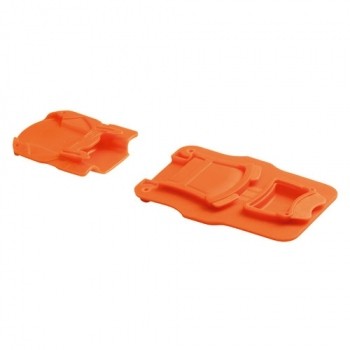
The anti-snow tires shaped insole, adapted under the crampons and not allow the soft wet snow sticking to them when walking. And here there is great expertise, there are simply levels antistoumpotika and Blur. These have been rather better performance.
Πηγή : Adventure Club Hellas
Recent posts
-
24/05/2024Backpack Guide Part Α’ 10 – 30 L
-
20/03/2024Guide for crampons
-
19/02/2024Hangboarding for beginners
-
06/02/2024Rock Climbing in Occupational Therapy
-
23/11/2023Climbing Grades
-
22/11/2023Climbing in psychotherapy
-
16/11/2023What is Bouldering
-
15/11/2023Trad VS Sport Climbing
-
15/11/2023Winter Tents
-
07/11/20233 Season Tents
-
03/11/2023Summer Tents
-
02/11/2023Lifespan Of Your Climbing Gear – Part B Metal Components
-
02/11/2023Lifespan Of Your Climbing Gear – Part A (Harness, Rope, Slings and Webbing)
-
30/10/2023Nail Vernis Aquaglutene - Vade Retro
-
30/10/2023THE LOG BOOK
-
30/10/2023Mountain cookware
-
30/10/2023Our Blog
-
30/10/2023Climbing Shoes - Quick Buying Guide
-
30/10/2023Washing and maintenance of the sleeping bag
-
30/10/2023Superlight Tents
-
30/10/2023ΙNFORMATION FOR CRAMPONS
-
30/10/2023Ice axe
-
30/10/2023INFLATABLE MATTRESS SLEEP
-
30/10/2023Nikwax secrets of waterproofing
-
30/10/2023What Is “Softshell”?
-
30/10/2023Slacklining, ένας εναλλακτικός τρόπος γυμναστικής.
-
30/10/2023Mountaineering - Hiking Boots
-
30/10/2023Waterproof Membranes
-
30/10/2023Sleeping Bags
-
30/10/2023Sleeping Mats
-
30/10/2023Base Layers
-
30/10/2023Climbing Helmets







